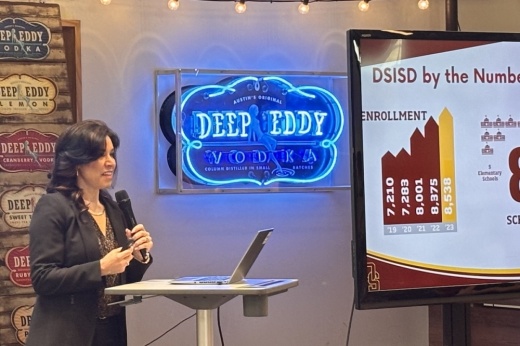Superintendent Holly Morris-Kuentz, Deputy Superintendent Elaine Cogburn and Assistant Superintendent Karen Kidd shared how the district is planning for growth, its current financial standing and how students find success.
District growth
Morris-Kuentz emphasized the district is rapidly growing and has seen an upward trend of students for the past 15 years. Dripping Springs has seen a 40% increase in the birth rate over the last four years, she said.
“When you think about our community, we have a lot of young families, and what that means is in addition to the families who will be moving here, we also have families who are already living here with preschool-aged children and will be coming to school in the next four years,” Morris-Kuentz said Feb. 28.
For the 2024-25 academic year, 8,900 students will be enrolled in the district, which has a capacity of 8,850.
To remedy this, district officials asked voters to fund projects to expand some schools in the district and design or construct new ones through a bond in May 2023.
Most recently, officials broke ground Feb. 16 on the Sycamore Springs Middle School expansion, which will increase the school’s capacity from 850 students to 1,200.
Budget explained
Cogburn said Feb. 28 the district is financially strong. In October, the district received the highest rating from the state for its financial transparency.
However, like other districts, DSISD will face a budget shortfall for fiscal year 2024-25 that will require cuts. Board policy also limits an adoption of a shortfall of more than 2% of projected revenues.
“For [FY 2024-25] we really are focusing on how we get our budget within the board parameter,” Cogburn said.
Despite growth in the district, Cogburn says DSISD isn’t growing at the same pace as it has in the past—impacting how the officials will plan for the budget next year.
“We were really hoping this last [legislative] session for some changes to be made [to the basic allotment],” Cogburn said. “That was not successful.”
The basic student allotment—the amount school districts receive from the state based on student enrollment and attendance—has not been raised since 2019, and is at $6,160. Cogurn said with inflation in mind, DSISD is keeping about $5,700 per student.
Who it’s for
Kidd said DSISD is “outperforming” in the Central Texas region when it comes to academic achievement.
The average DSISD student meets their grade level based on spring State of Texas Assessments of Academic Readiness results. DSISD students in grades 3-8 continue to have higher passing averages than the rest of the state since 2021 and higher passing averages for reading than for math.
DSISD has a 98% graduation rate, compared to the state rate of 92.8%.
“Our campuses give students opportunities every day of every year for leadership, collaboration and communication,” Kidd said.
For more information, visit www.dsisdtx.us.





